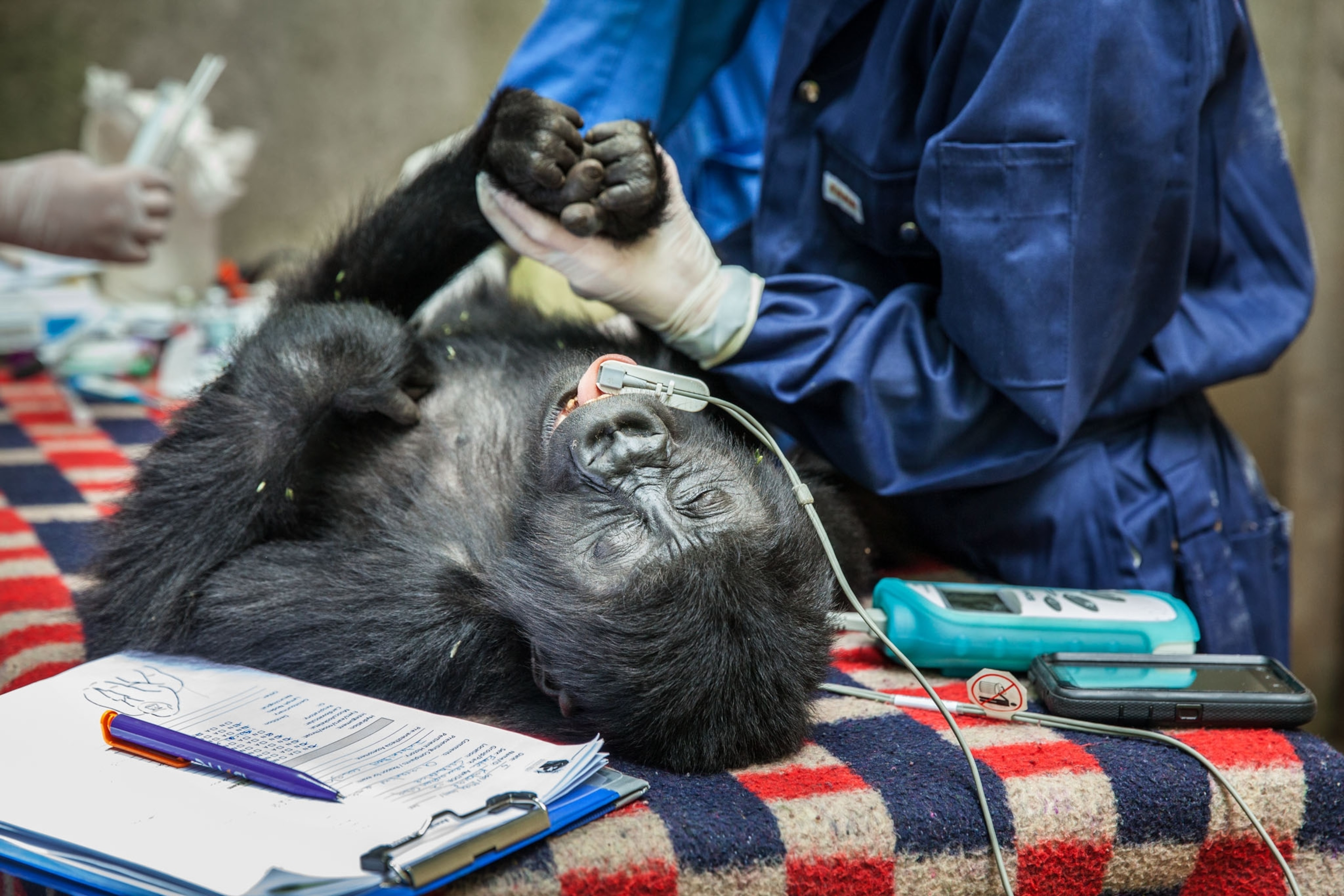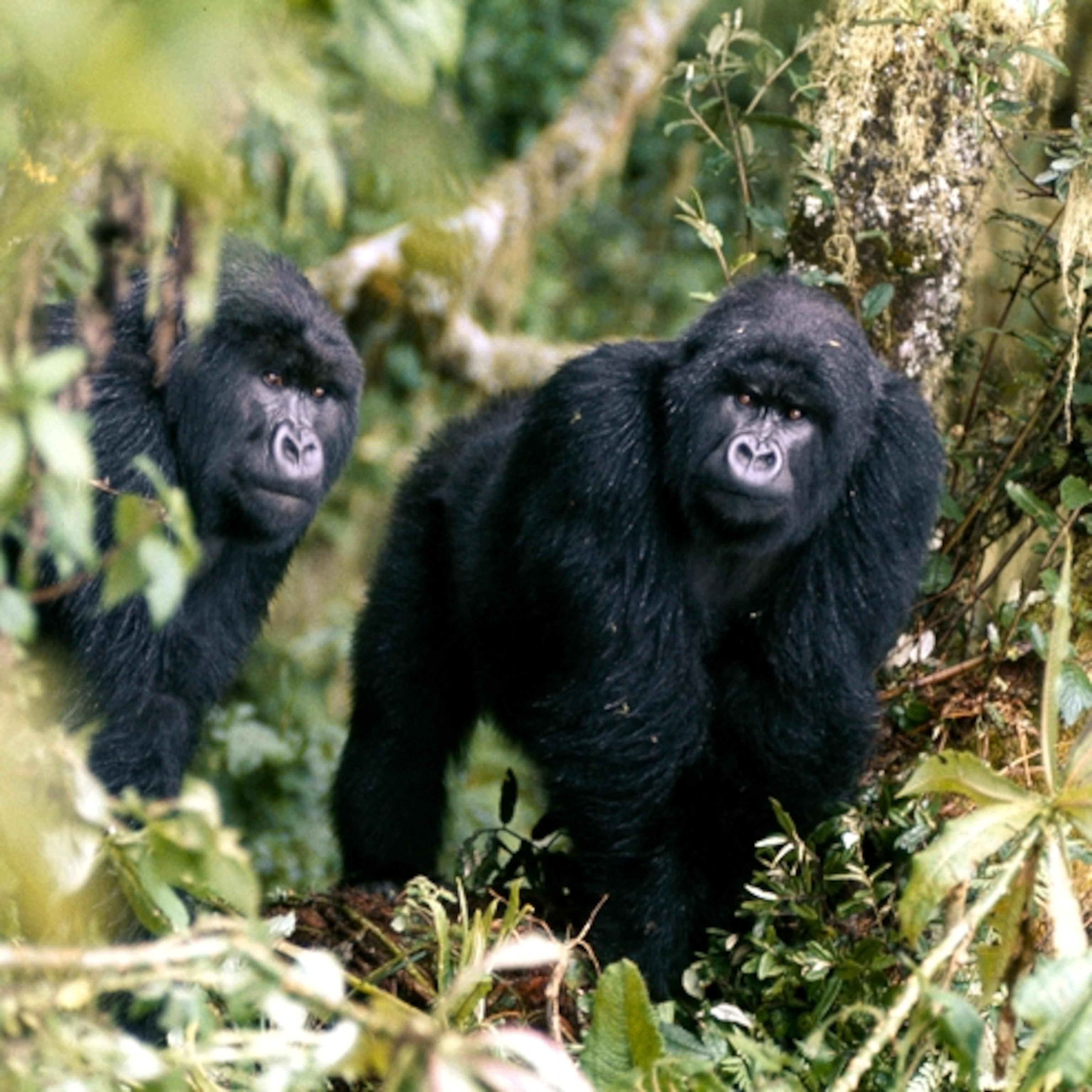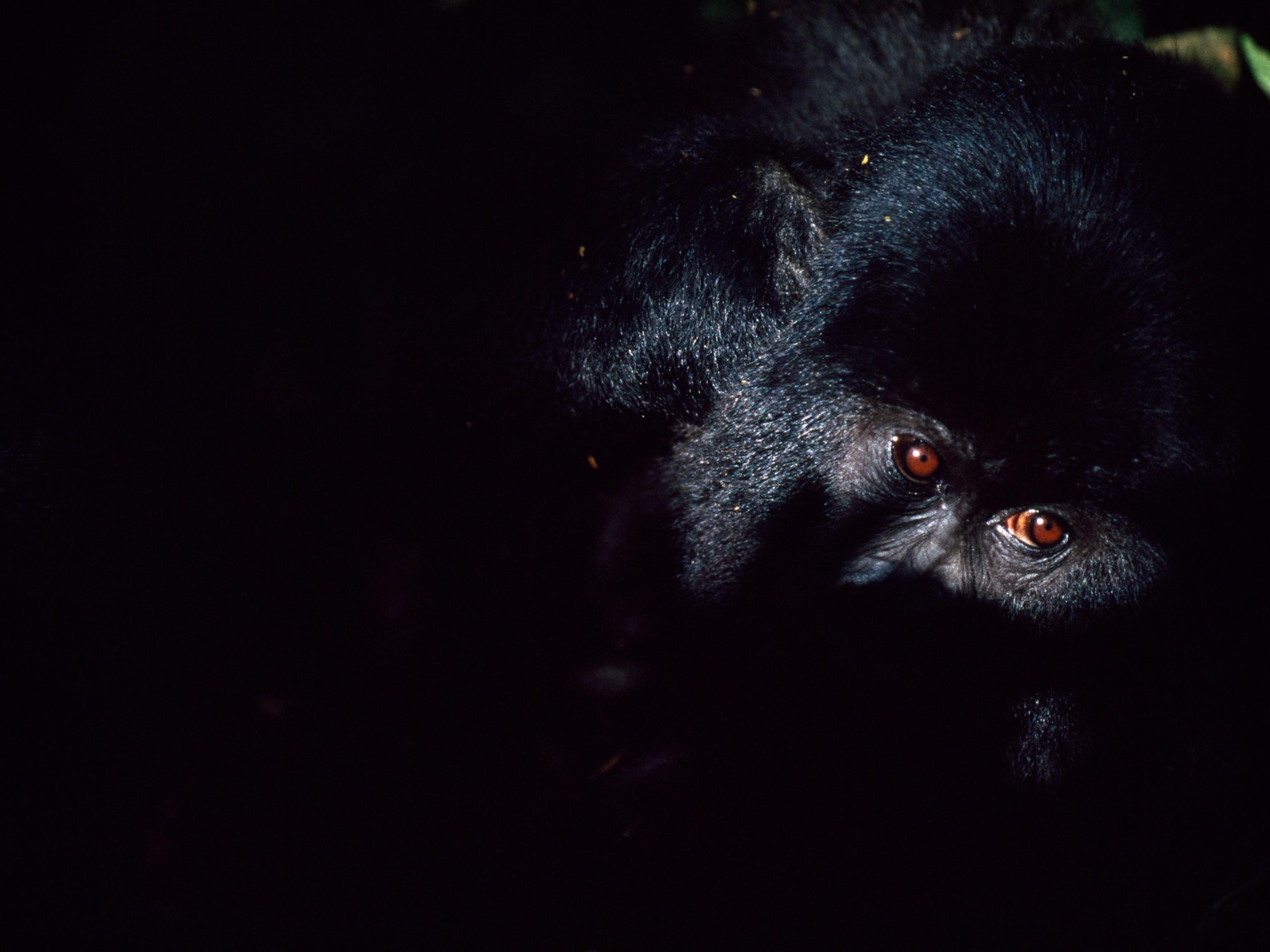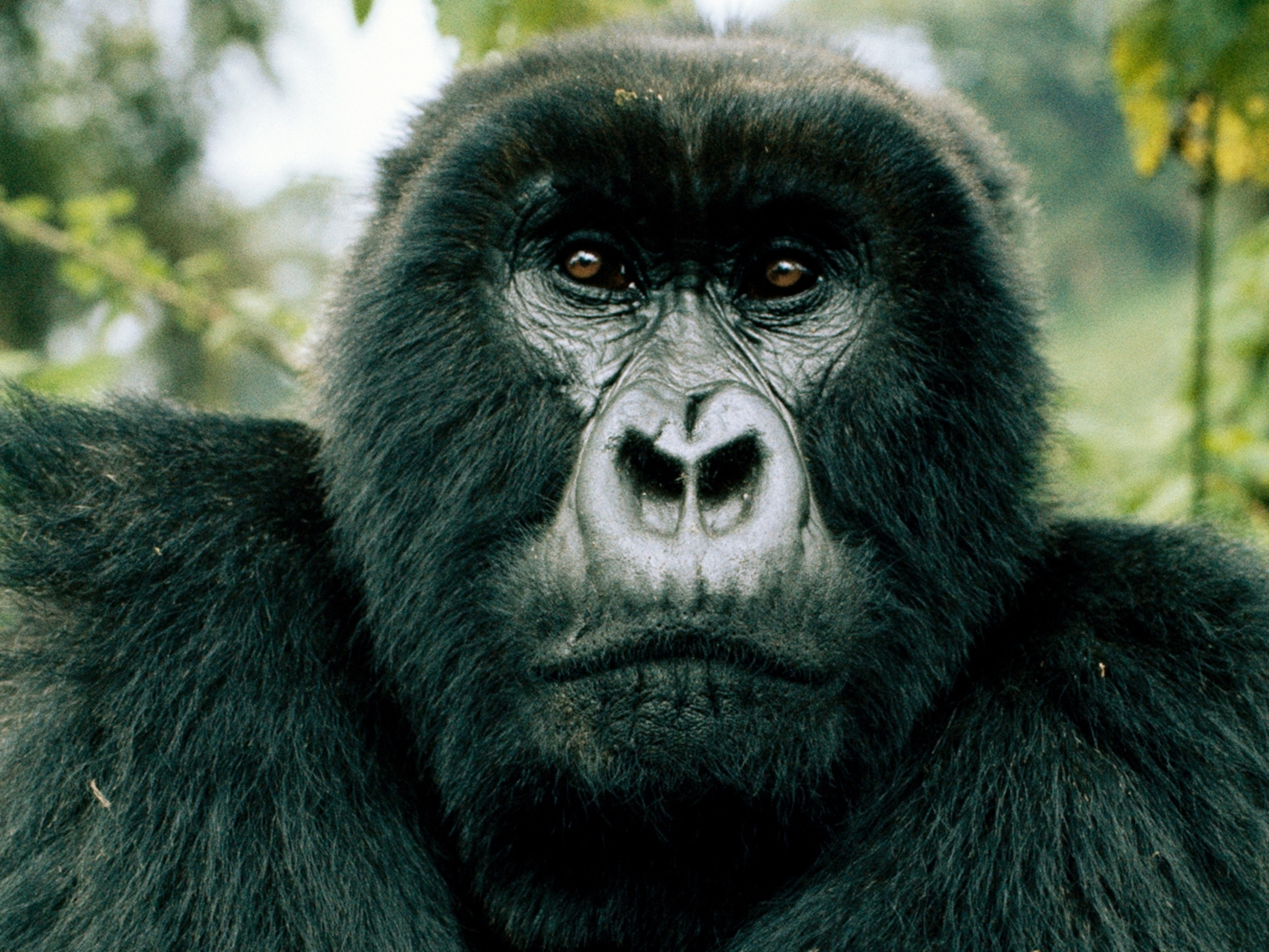
Meet the Vets Risking Their Lives to Treat Wild Gorillas
Negotiating with rebels and being charged by silverbacks is just another day on the job for the Gorilla Doctors.
GOMA, Democratic Republic of the Congo—Trackers swing their machetes at the thick jungle, and veterinarians Eddy Kambale and Martin Kabuyaya follow behind, armed with cameras and clipboards. The tangled vines hide the forest's many dangers: poachers, rebels, and herds of wild elephants.
After a few hours, a path of trampled brush leads to a clearing where a group of mountain gorillas have made their nests for the day. A silverback chomps on handfuls of leaves in the shade, and babies swing between trees. The vets snap pictures and scribble down notes.
Every month Kambale and Kabuyaya trek into the jungles of Virunga National Park in the volatile eastern Democratic Republic of the Congo to assess each gorilla’s health. They identify any injuries that may require treatment and, if necessary, perform surgery.

But Virunga is also home to the other kind of guerrilla—and sometimes the veterinarians encounter armed rebels blocking access to their patients. "The first thing is to engage their leader in conversation," says Kambale. "I tell them, 'I’m just a vet.'"
In 1985 Dian Fossey hired veterinarian James Foster to join her research station in Rwanda as the first "gorilla doctor." A few weeks later Fossey was murdered—a crime that is still unsolved—but Foster came anyway, opened his clinic, and carried on the American primatologist's legacy.
Today 15 vets work for the organization he founded, the Gorilla Doctors, to care for the world’s last 880 mountain gorillas, who live on the border between Uganda, Rwanda, and the Democratic Republic of the Congo. They also look after rescued apes, who live in the Senwekwe Center, the world’s only sanctuary for mountain gorillas.
The critically endangered species has made a remarkable comeback, thanks in large part to Fossey's work, but deforestation, poaching, and war continue to threaten their existence.
A Jungle of Threats
In 2013, a rebel group called M23 seized the lodge and gorilla habitat in Virunga, Africa’s oldest national park. Insurgents surrounded the Senkwekwe Center, preventing the Gorilla Doctors from accessing it. In the chaos, Kaboko, a one-armed gorilla, became sick with diarrhea overnight. With the roads to Virunga's headquarters blocked, he died early the next morning.
The veterinarians considered evacuating to Rwanda with the rest of the sanctuary’s great apes, but that would leave their families alone in the middle of war. Instead, they struck an agreement with the rebels to continue caring for their patients. (Read about Virunga's park warden, National Geographic Explorer Emmanuel de Merode, who is battling to save gorillas amid brutal conflict.)

They would drive out of Goma, past United Nations bases and Congolese Army stations, to the park border. Then they'd show their identification and the rebels would wave them through.
Those rebels are gone now, but many other groups remain in the park. The doctors spend their days on this front line, treating gorillas when they’re sick, hurt, or in danger. (Read about the battle for Africa's oldest national park.)
The vets collaborate with the Dian Fossey Gorilla Fund, a U.S.-based gorilla research organization, to collect information about each gorilla’s behavior before intervening. This is critical for their safety—as Kambale learned after being charged by a protective silverback while trying to remove a snare from a baby gorilla.

"In cases where urgent intervention is required, every moment counts," says David Greer, an adviser to the WWF African Great Apes Programme, who has worked with the vets for more than 20 years. In stressful situations gorillas often "become quite aggressive," and skilled hands are vital. The Gorilla Doctors, he notes, are "extremely dedicated, courageous, and professional."
The veterinarians have worked through some of Virunga's darkest moments.
In 2007 poachers—possibly led by a corrupt then-warden—massacred seven gorillas. With nowhere to keep the young survivors, the park moved them into Gorilla Doctors' offices in Goma and then to the new Senwekwe Center (named for the murdered silverback of the group). They were later joined by Maisha and Kaboko, both of whom were taken from poachers.

In Case of Emergency
Despite a quarter century of regional conflict, the mountain gorilla population is bouncing back from the brink of extinction—where it was when Fossey began her work. Greer attributes this to tourism, government intervention, and the veterinarians' work. But, he notes, with fewer than a thousand members of the species left, "we do not have the luxury to let our guard down." One threat in particular frightens Greer: "A newly introduced virus into the population has the potential to inflict catastrophic harm," he says.
Last year the Gorilla Doctors took on an additional role: first responders.
In the supply room of their lab in Goma, Kambale opens a box of crinkly hazmat suits. The first cases of Ebola appeared in 1976 around its namesake river in northern DRC, and over the past three years the country has battled two Ebola outbreaks. Endangered gorillas are not spared by the virus, which makes the doctors' work even more important. (Read the lessons learned on how to stop Ebola in its tracks.)
Wild animals like monkeys and bats sold for food are one of the deadliest conduits of the disease. In 2014, Kambale and his team began investigating the bush-meat trade in a town near Virunga. With lab tests, the vets determined which viruses the animals carried, and they mapped how the germs spread using notes from their interviews.

In the DRC, villages are remote and roads impassable, so Ebola outbreaks haven’t spread as rapidly there as in other countries.
But if the virus appears in the eastern province where the Gorilla Doctors work, they’ll be among the first dispatched to track its source—and help contain the disease before it reaches the remaining mountain gorillas and the humans who live near them.
On the Watch
In the meantime, the vets are always on the lookout for emerging epidemic threats.
They gather samples from rodents in the park, baboons that terrorize Virunga’s sprawling headquarters, and people who live and work in its confines. Despite the risks, Kambale is glad of their new role in disease surveillance. "When you have good control, it limits the risk to human health," he says. (See pictures of orphan gorillas rescued from poachers.)
All the while they keep a trained eye on the gorillas.

In their lab, plates are smeared with blood and feces from 17-year-old Maisha.
In Swahili, her name means "life," but recently her listless behavior had the veterinarians worried. She'd been losing weight since her companion, the one-armed Kaboko, died during a rebel attack on their shared sanctuary a few years earlier.
Nothing showed up on an x-ray or an ultrasound, so the doctors sent the samples to a lab that seems unfathomably far from the rain forests of central Africa: Disney World’s Animal Kingdom. When their lab didn't find anything suspect in her samples, the stumped vets tried to help her as much as possible before she passed away in July.
Even so, these gorillas are the lucky ones in the DRC’s animal kingdom. None of the country's nine other national parks have a dedicated veterinary unit committed to preventing mountain gorillas from disappearing.
WWF's David Greer hopes that someday the Gorilla Doctors' presence won't determine life or death for the species. "We need to find ways of creating an environment where we don't have to rely on veterinary intervention for the continued survival of the mountain gorilla," he says.
Related Topics
Go Further
Animals
- How can we protect grizzlies from their biggest threat—trains?How can we protect grizzlies from their biggest threat—trains?
- This ‘saber-toothed’ salmon wasn’t quite what we thoughtThis ‘saber-toothed’ salmon wasn’t quite what we thought
- Why this rhino-zebra friendship makes perfect senseWhy this rhino-zebra friendship makes perfect sense
- When did bioluminescence evolve? It’s older than we thought.When did bioluminescence evolve? It’s older than we thought.
- Soy, skim … spider. Are any of these technically milk?Soy, skim … spider. Are any of these technically milk?
Environment
- Are the Great Lakes the key to solving America’s emissions conundrum?Are the Great Lakes the key to solving America’s emissions conundrum?
- The world’s historic sites face climate change. Can Petra lead the way?The world’s historic sites face climate change. Can Petra lead the way?
- This pristine piece of the Amazon shows nature’s resilienceThis pristine piece of the Amazon shows nature’s resilience
- Listen to 30 years of climate change transformed into haunting musicListen to 30 years of climate change transformed into haunting music
History & Culture
- Meet the original members of the tortured poets departmentMeet the original members of the tortured poets department
- Séances at the White House? Why these first ladies turned to the occultSéances at the White House? Why these first ladies turned to the occult
- Gambling is everywhere now. When is that a problem?Gambling is everywhere now. When is that a problem?
- Beauty is pain—at least it was in 17th-century SpainBeauty is pain—at least it was in 17th-century Spain
Science
- Here's how astronomers found one of the rarest phenomenons in spaceHere's how astronomers found one of the rarest phenomenons in space
- Not an extrovert or introvert? There’s a word for that.Not an extrovert or introvert? There’s a word for that.
- NASA has a plan to clean up space junk—but is going green enough?NASA has a plan to clean up space junk—but is going green enough?
- Soy, skim … spider. Are any of these technically milk?Soy, skim … spider. Are any of these technically milk?
Travel
- Could Mexico's Chepe Express be the ultimate slow rail adventure?Could Mexico's Chepe Express be the ultimate slow rail adventure?
- What it's like to hike the Camino del Mayab in MexicoWhat it's like to hike the Camino del Mayab in Mexico







